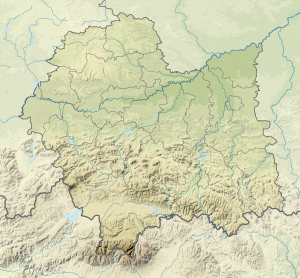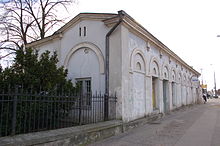Palais Biernacki
| Palais Biernacki | ||
|---|---|---|
|
Main facade |
||
| Creation time : | 1750 | |
| Castle type : | Palace | |
| Conservation status: | Receive | |
| Place: | Warsaw | |
| Geographical location | 52 ° 14 '5 " N , 20 ° 58' 29" E | |
|
|
||
The Palais Biernacki or Biernacki-Palais (Polish: Pałacyk Biernackich ) is a small and listed, former residence in the Warsaw district of Wola on Ulica Wolska 27/29 . Today there is a monastery run by nuns here.
history
The banker Karol Schultz originally owned a garden here in the second half of the 18th century. Around the turn of the century, the wealthiest landowner in Wolas, Jan Chryzostom Biernacki, acquired this facility. Around 1850, the small palace was built on the site for Adam Biernacki, based on a design by Józef Orłowski . It had a rectangular, uneven floor plan, two storeys and was kept in the classicist style of the time. Two short winged buildings were attached to the sides. The semicircular central projection on the front side, which accommodates the entrance to the palace, is striking . Small outbuildings on the east side and along the Wolska formed a courtyard to the south (today the busy, six-lane Aleja Solidarności runs here ) .
In 1929 the property was donated to the Archdiocese of Warsaw by Celestyna Biernacka, the daughter of Adam Biernacki . This initially used it as a church museum and as a dormitory for a seminary . Eventually it was assigned to the Order of the Discalced Carmelites as a place of residence.
During the occupation in World War II , the nuns supported the Jewish Fighting Organization (ŻOB) that had formed in the ghetto . The organization maintained a contact point in the monastery. During the Warsaw Uprising in August 1944, there were mass shootings in the immediate vicinity of the palace. A plaque on the building reminds of this:
“ Miejsce uświęcone krwią Polaków poległych za wolność ojczyzny. W sierpniu 1944 roku przy ul. Wolskiej pod nr 29 oraz nr 4/6/8 hitlerowcy wymordowali około 3200 osób "
“ This place is sanctified by the blood of Poles who fought for the freedom of their fatherland. In August 1944 the Nazis murdered around 3,200 people in buildings number 29 and 4/6/8 "
Even today the building is operated as a convent of the Carmelites, who live here in asceticism and seclusion. The orchard and vegetable garden they cultivate surrounds the ensemble of buildings in the south and west ( reaching up to Ulica Młynarska ) on an area of around 20,000 square meters.
References and comments
- ↑ Jan Chryzostom Krzysztof Biernacki (around 1750–1811)
- ↑ Józef Orłowski (1819–1880) was a Polish architect
- ↑ Adam Michał Biernacki (* 1824)
- ↑ according to Information ( page no longer available , search in web archives ) Info: The link was automatically marked as defective. Please check the link according to the instructions and then remove this notice. at Pascal.pl (in Polish)
- ↑ Convent of the Discalced Nuns, Order of the Most Blessed Virgin Mary of Mount Carmel (Polish: Klasztor Mniszek Bosych, Zakonu NMP z Góry Karmel )
See also
literature
- Julius A. Chroscicki and Andrzej Rottermund, Architectural Atlas of Warsaw , 1st edition, Arkady, Warsaw 1978, p. 225
Web links
- Brief description on the website of the district administration (in English)
- Description with photos at Wiezowce.waw.pl (in Polish)
- Brief description with photos at Klimatwarszawy.pl (in Polish)





